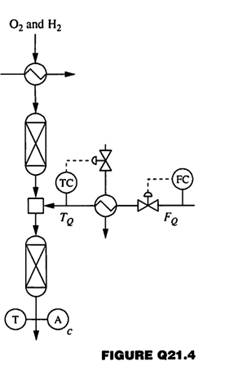A linear transfer function model of a chemical reactor was determined by Foss et al. (1980) and simplified by Marino-Galarraga et al. (1987a). The reaction of oxygen and hydrogen over a catalyst occurs in two beds, with cold hydrogen quench added between the beds. The reactor is shown in Figure Q21.4, and the model is given below. The units are composition in mole%, temperatures in °C/167.4, flow in L/min/13.5, and time in sec/87.5. Assume that both controlled variables are of equal importance. Answer the following questions for two cases: (1) the input perturbation is a set point change to the composition controller and (2) the input perturbation is a change to the cooling medium temperature, so that the disturbance transfer function is the second column of the following matrix (the same effect as a change in the manipulated quench temperature)
(a) Determine whether the input-output combination is controllable. (b) Determine if either loop pairing can be eliminated based on the sign of the relative gains.
(c) Select the loop pairing based on an estimate of the control performance.
(d) Determine the initial tunings for PI controllers for the best loop pairing. Answer this question for (1) the temperature and product composition of equal importance and (2) the temperature more important.
(e) Discuss whether decoupling is recommended and if so, design the decoupler.
(f) Discuss whether feedforward compensation would improve the control performance and if so, design the feedforward controller.



